|
The
process began in 1970 at the Provincial Grand Lodge headquarters, Atlantic
House, Cape Town. R.W.Bro. Morris Levin and senior Masonic officials of other
constitutions met with over forty Colored men, members of two Prince Hall
Lodges, St. Patrick’s and Southern Cross, who were anxious to join the Grand
Lodge of South Africa (GLSA). (see doc1)
Prince
Hall Masonry, which had existed in South Africa for over seventy years, was as
yet unrecognized by ‘Regular’ Freemasonry and its members felt isolated from
their own Grand Lodge in Philadelphia, USA.
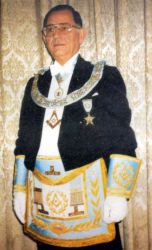
R.W.Bro. Morris Levin, 33°, O.S.M, is a Past Deputy Grand Master of the Grand Lodge of South Africa and is a life member of the Supreme Council, Northern Jurisdiction, of the United States.
He has been honored with the O.S.M (Order of Service to Masonry) award, by both the Grand Lodge of South Africa and the Supreme Grand Royal Arch Chapter of South Africa.
He also holds an OM (Order of Merit) from the Grand Lodge of Israel.
|
R.W.Bro.
Levin describes the Prince Hall Masons as being “top quality material” and
“highly cultured people”, recalling that most of them were teachers,
lawyers, doctors and business people.
Representatives
of the English, Irish and Scottish constitutions, which operate alongside the
South African Grand Lodge, were present at the meeting and kept informed
throughout the process.
The
conditions necessary for GLSA approval (see doc2) required the Prince Hall Lodges to fully surrender
their Prince Hall charters (see doc3)
and sever all connections with the Grand Lodge of Prince Hall. The members would
also need to be re-initiated, passed and raised in accordance with the usages
and customs of GLSA. They would also be issued new aprons and given GLSA
Diplomas, after which they would enjoy the same rights and privileges as all GLSA
members.
These
conditions were agreed upon unanimously and a document drawn up on 14 September
1973, containing the signatures of all the Prince Hall members, was delivered to
R.W.Bro. Morris Levin. (see doc4)
The
next step was to present the case to the government. Full membership for Colored people was impossible under
Apartheid laws. The Group Areas Act had created separate residential areas to
enforce physical separation between races, and the Liquor Act and Assembly Act
effectively banned ‘whites’ from socializing or drinking with
‘non-whites’.
A
document of conditions R.W.Bro. Levin recalls as being “very stringent” in
order to “overcome the expected opposition from the government” was produced
and the decision to go ahead with the proposal was made on 25 August 1973 at a
Grand Committee meeting attended by all commissioned officers and officers of
the Grand Lodge. R.W.Bro. Morris Levin was here appointed convener of the
negotiations.
In
1977, after three meetings with a Parliamentary committee held over three years,
R.W.Bro. Levin met with the Committee of Internal Affairs. The committee, which included Adriaan Vlok, Dr. Piet Koornhof, Dr. Connie Mulder, Barend Du Plessis and Eschel Rhoodie, were
“for the setup” but Prime Minister Vorster was “dragging his feet”.
A letter from the Secretary of Community Development
was then received which stated that
permit authorization was not required for Colored members to attend a closed
function such as a normal Lodge meeting held on property owned by the Lodge.
These allowances were still not permissive enough
for Colored people to be made ‘fully-fledged’ members.
Next,
a meeting was held with Prime Minister John Vorster and the head of
intelligence, General Van Den Berg who urged the Prime Minister to “move it”
and grant permission. Van Den Berg did not mention to Vorster that he was a
school time friend of the Grand Master, M.W.Bro. Eddie Conradie.
After
four years of hard work by many Freemasons and with much help from General Van Den Berg’s
involvement, the final breakthrough in negotiations came through an
“unexpected support” met during the opening of a home for the aged. Dave
Levitan, a member of Lodge Kaapstad, was on “very friendly terms” with Prime
Minister Vorster’s wife and she was invited to be the Patron of the home. Many
Freemasons, including R.W.Bro. Morris Levin, were present at the occasion and
support was found from the Prime Minister’s wife. After hearing Morris’ case
- which argued that it was “a worldwide opportunity to show that we are not
racist” - she assured him she would see what she could do.
R.W.Bro.
Levin, who was Assistant Grand Master at this stage, recalls with a laugh that
“the next thing we knew we got a letter granting permission!”.
On
19 Nov 1977, in a series of workings going right through the day, the Prince
Hall members were Initiated, Passed and Raised at the De Goede Hoop Temple in
Cape Town. The first degree working was performed by the Provincial Grand Lodge
officers, followed by the second degree performed by Lodge Kaapstad. They then
stopped for lunch, after which they reassembled for the third degree, performed
by Lodge De Goede Hoop. (see doc5)
R.W.Bro.
Levin remembers there were “hundreds of people” and it was “hot as
hell”. After all the workings were complete, the new Grand Master, M.W.Bro. S.R Gasson,
consecrated the Lodges Perseverance and Phoenix, and a mixed banquet attended by
over 400 people followed.
The news of Freemasonry accepting Colored brethren
was reported in national newspapers including ‘Rapport ‘(13 Nov), ‘Cape
Times’ (14 Nov), ‘Citizen’ (14 Nov) and ‘Cape Argus’ (16 Nov). (see doc6)
At this time there were approximately 4500 members
of the GLSA and around 50 000 members of its sister constitutions. A circular
was sent to all English Lodges by the District Grand Master of the English
Constitution saying that it “recognizes Colored brethren of Lodge Perseverance
and Lodge Phoenix”, who could now visit any of the sister constitution Lodges.
(see doc7)
Through
the remaining years of Apartheid, it was possible to "accept Colored and Muslim
men as full members and many of them have achieved high
office in the Grand Lodge" and "many Brethren of color are currently holding
office in Provincial Grand Lodges around the country".
Documents
doc1
The Notice given to GLSA
by Prince Hall members declaring their wish to join the GLSA.
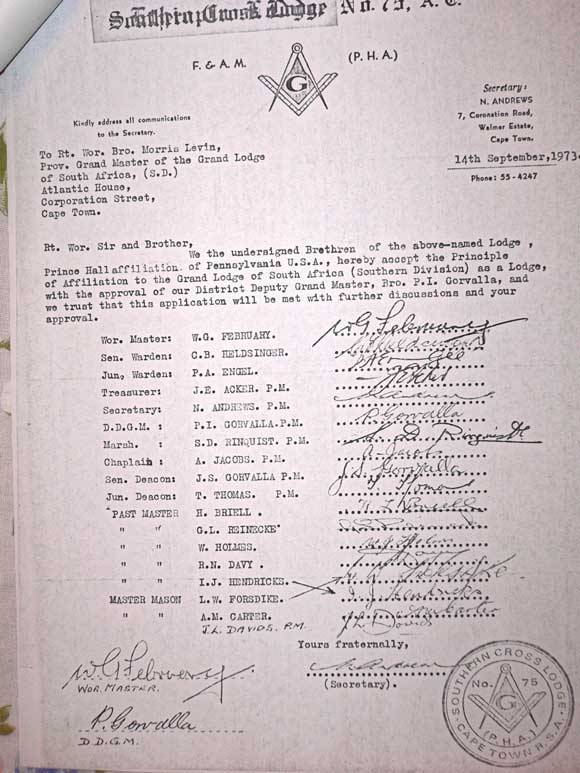
doc2
The document given to the Prince Hall Members stating the GLSA conditions
for the takeover.
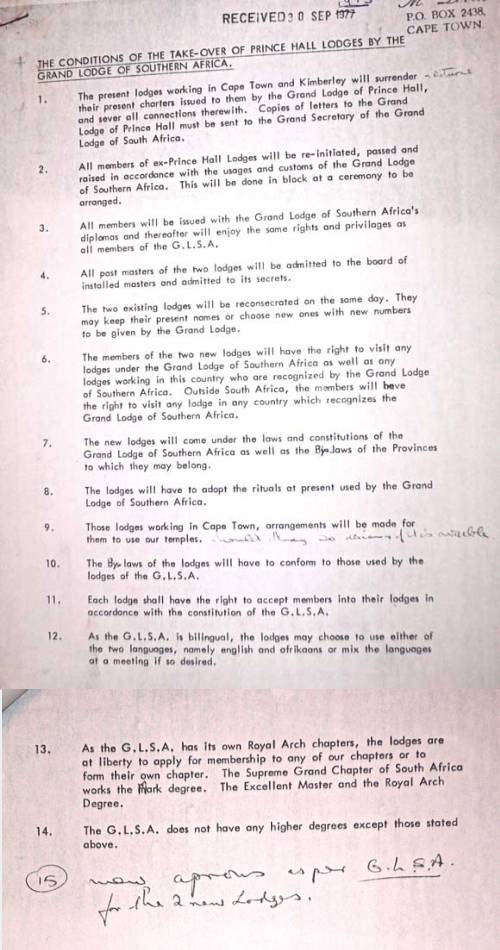
doc4
The Principle of Affiliation, the conditions were agreed
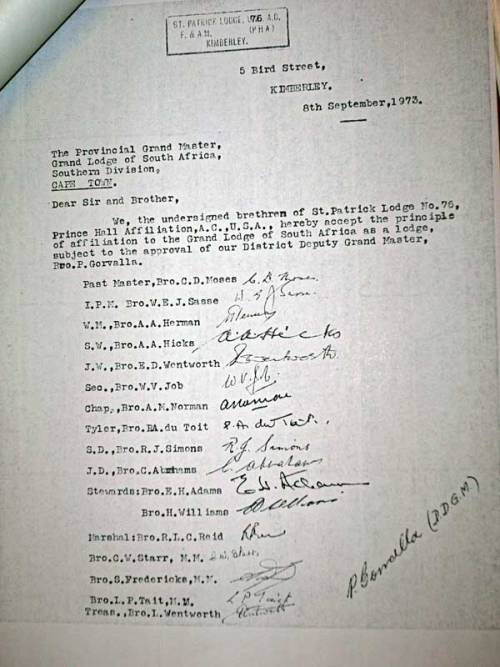
doc5
Admission of Coloureds as Members of G.L. of South Africa
Consecration Agenda
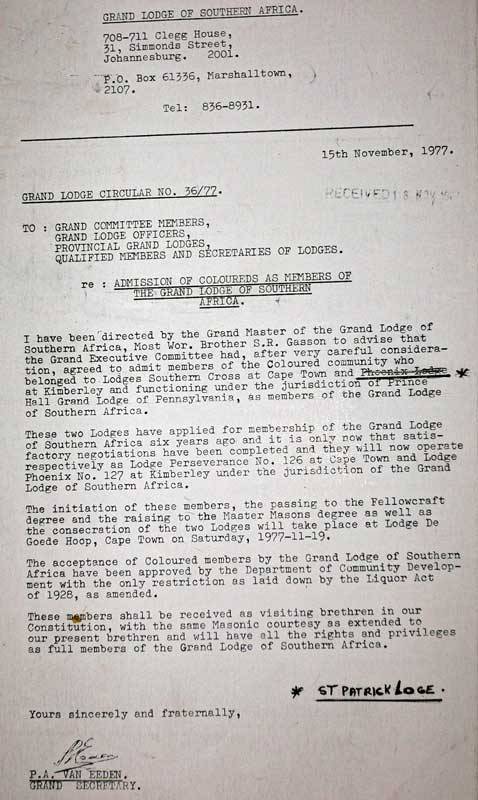
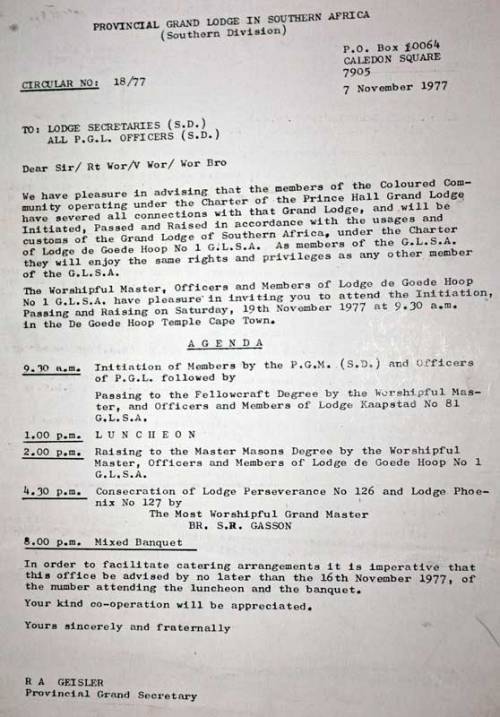
| ![]()
 Subscribe News by Email
Subscribe News by Email
![]()
![]()
![]()
![]()